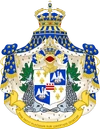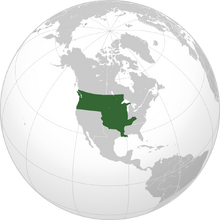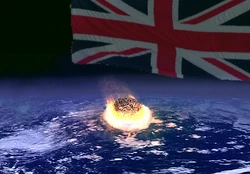| |||||||
| Anthem | "For Louisiana" | ||||||
| Capital | Nouvelle Orleans | ||||||
| Largest city | Chicagou | ||||||
| Other cities | St. Louis, Sault. Ste Marie, Prudhomme, Petite Roche, Ste-Geneviève, La Baie Verte | ||||||
| Language official |
French | ||||||
| others | Dutch, Spanish | ||||||
| Ethnic Groups main |
White (non-Hispanic), Cajun | ||||||
| others | Black, Native American | ||||||
| Demonym | Louisianian | ||||||
| Government | Unitary presidential constitutional republic | ||||||
| President | Jean Breaux | ||||||
| Population | 80.12 million | ||||||
| Established | July 24, 1534 | ||||||
| Independence | from France | ||||||
| declared | 1803 | ||||||
| recognized | 1810s | ||||||
| Currency | Louisianian franc (₣) (LAF)
| ||||||
| Time Zone | (UTC−7)-(UTC-9) | ||||||
| Internet TLD | .la | ||||||
| Organizations | North American Confederation, NATO | ||||||
The Republic of Louisiana, or just Louisiana, is a sovereign state located in North America. Louisiana is a unitary state bordered by Alaska to the north, Canada to the northeast, Mexico to the south, California to the southwest, and New Orange and Florida to the east.
Etymology[]
Louisiana was named after Louis XIV, King of France from 1643 to 1715. When René-Robert Cavelier, Sieur de La Salle claimed the Mississippi River drainage basin for France, he named it La Louisiane. -Ana (or -ane) is a Latin suffix that can refer to "information relating to a particular individual, subject, or place." Therefore, roughly, Louis + ana carries the idea of "relating to Louis."
History[]
French exploration[]
In 1660, France started a policy of expansion into the interior of North America from what is now eastern Canada. The objectives were to locate a Northwest Passage to China; to exploit the territory's natural resources, such as fur and mineral ores; and to convert the native population to Catholicism. Fur traders began exploring the pays d'en haut (upper country around the Great Lakes) at the time. In 1659, Pierre-Esprit Radisson and Médard Chouart des Groseilliers reached the western end of Lake Superior. Priests founded missions, such as the Mission of Sault Ste. Marie in 1668. On May 17, 1673, Louis Jolliet and Jacques Marquette began the exploration of the Mississippi River, which they called the Sioux Tongo (the large river) or Michissipi. They reached the mouth of the Arkansas River, and then returned upstream, having learned that the great river ran toward the Gulf of Mexico, not toward the Pacific Ocean as they had presumed. In 1675, Marquette founded a mission in the Native American village of Kaskaskias on the Illinois River. A permanent settlement was made by 1690.
In 1682, Cavelier de La Salle and the Italian Henri de Tonti descended to the Mississippi delta. They left Fort Crèvecoeur on the Illinois River, accompanied by 23 Frenchmen and 18 Indians. They built Fort Prud'homme (later the city of Prudhomme) and claimed French sovereignty on the whole of the valley, which they called Louisiane in honor of the Louis XIV of France. They sealed alliances with the Quapaw Indians. In April 1682, they arrived at the mouth of the Mississippi. La Salle eventually returned to Versailles, where he convinced the Minister of the Marine to grant the command of Louisiana to him. He claimed that Louisiana was close to New Spain by drawing a map showing the Mississippi as much farther west than it really was.
With four ships and 320 emigrants, La Salle set sail for Louisiana. La Salle was not able to find the river's mouth in the Mississippi River Delta and attempted to establish a colony on the Texas coast. La Salle was assassinated in 1687 by members of his exploration party, reportedly near what is now Navasota, Mexico.
New France[]
Many strategic forts were built in Louisiana, under the orders of Governor Louis de Buade de Frontenac. Forts were also built in the older portions of New France that had not yet been settled. Many of these forts were garrisoned by the Troupes de la Marine, the only regular soldiers in New France between 1683 and 1755.
In 1698, Pierre LeMoyne d'Iberville left La Rochelle and explored the area around the mouth of the Mississippi. He stopped between Isle-aux-Chats (now Cat Island) and Isle Surgeres (renamed Isle-aux-Vascular or Ship Island) on February 13, 1699 and continued his explorations to the mainland, with his brother Jean-Baptiste Le Moyne de Bienville to Biloxi. He built a precarious fort, called 'Maurepas' (later 'Old Biloxi'), before returning to France. He returned twice in the Gulf of Mexico and established a fort at Mobile in 1702.
From 1699 to 1702, Pierre Le Moyne d'Iberville was governor of Louisiana. His brother succeeded him in that post from 1702 to 1713. He was again governor from 1716 to 1724 and again 1733 to 1743. In 1718, Jean-Baptiste Le Moyne de Bienville commanded a French expedition in Louisiana. He founded the city of New Orleans, in homage to Regent Duke of Orleans.
Vermont War (1750-1753)[]
The Vermont War, which was triggered by the Dutch annexation of French Vermont, had its effect on Louisiana. Dutch troops were able to take French lands in present-day Ohio, New Canada, and parts of Allegheny and Appalachia.
Independence (1803)[]
The French Civil War broke out in 1789, when the monarchy in France was overthrown, starting the infamous "Reign of Terror" for around two decades. In New France, minor battles and rioting broke out between the royalists and nationalists during the war, though full-scale conflict never erupted.
As it was mostly populated by French merchants and settlers, New France was one of the last French colonies to declare independence during the French Civil War. New France then split: areas north and east of the Great Lakes became Canada, while the rest of the former colony became Louisiana. Since it was the nationalists who were proponents for independence, they established a constitutional republic, following the model of New Orange. The Treaty of Paris, signed in the 1810s, ended the French Civil War. It forced France to recognize the independence of the colonies it lost in the war, giving Louisiana formal recognition.
Government & Politics[]
Administrative divisions[]
Louisiana is a unitary state composed of 10 administrative regions.
Atchafalaya (Vermilionville)
Arkansaw (Petite Roche)
Jolliet
Kentucky (Prudhomme)
Illinois (Fort de Chartres)
Ouisconsin (La Baie Verte)
Dakote
Absaroque
Oregon Sud
Oregon Nord
| ||||||||||||||||
| ||||||||||||||||||||||||





